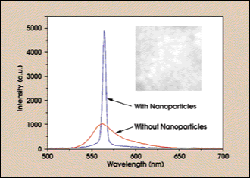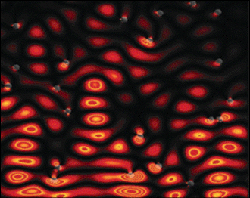Photonics Spectra editors
A team of researchers from the Ultrafast Photonics and Nano-Optics Laboratory at the University of Alberta in Edmonton, Alberta, Canada, has created a surface-plasmon-enhanced random laser by suspending silver nanoparticles in a laser dye. The surface plasmon enhancement of both scattering and electromagnetic fields caused by the 55-nm-diameter particles in a solution of rhodamine 6G enables lasing at a low-threshold pump energy fluence. When pumped by a frequency-doubled Nd:YAG laser, the random laser produces bright emission at 564 nm with a linewidth of less than 4.5 nm.
Previously reported random lasers function in a regime wherein multiple scattering events provide nonresonant optical feedback. The plasmonic silver-scatterer-based random laser, however, can function even in a regime where single scattering events are rare. For this to occur, each rare scattering event must cause a large amount of optical gain.
The plasmonic enhancement of electromagnetic fields near the particle's surface provides this gain. Collocalization of pump and laser radiation around the metal particle also increases the optical gain that a scattering event causes. Thus, a silver-nanoparticle-based random laser has a significantly narrower laser linewidth and lower lasing threshold than a random laser constructed from the suspension of dielectric scatterers in a laser dye.

Figure 1. The surface-plasmon-enhanced random laser displays a much narrower linewidth and much greater intensity than a dye laser that lacks the silver nanoparticles. The inset is a scanning electron micrograph of the 55-nm-diameter particles suspended in the rhodamine 6G dye.
In experimental tests, a 20 percent decrease in the laser linewidth was observed for the silver-scatterer-based random laser, compared with a dielectric scatterer random laser (Figure 1). At a typical pump energy fluence of 25 mJ/cm2, the peak light output was more than 500 times that at low pump fluence.
Given the size of the particles, the work suggests possible applications in nanophotonics and nano-optics. A random laser constructed with metallic scattering particles might enable the development of very small coherent light sources for various photonic devices, which might be used to optically label items for identification purposes.

Figure 2. A finite-difference time-domain simulation reveals the intensity distribution surrounding an ensemble of silver nanoparticles in the device.
A plasmonic random laser also could be used for sensing applications as a result of the dependence of surface plasmon behavior on the environmental conditions surrounding the particle. And optical displays may benefit because of the lower threshold required for operation compared with dielectric-based random lasers.